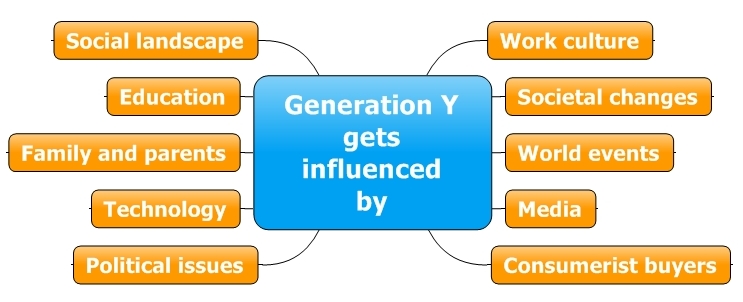It takes more than selective targeting to market effectively to Generation Y. Members of Generation Y seeks products that create an ambiance and community experience, rather than just provide a function. They like brands to express a reality in which they are involved, interconnected, and interactive. To be successful, build a brand with them, not for them. Computers have made knowledge cool through a fusion of fun and learning. Merchandise concepts that make exploring the unknown fun, bring information to life, or challenge consumers to design their own products will be a sure-fire hit. Also, look for cause-related tie-ins, lifestyle sponsorships, interactive promotions, etc. to become more means by which brands can provide memorable experiences and build community. Some very large brands are struggling to learn these lessons. Therefore, they are having difficulty earning the loyalty of today’s youth. Labels that defined popular tastes when Baby Boomers were young are no longer fashionable. Names such as Nike and Levi-Strauss are battling falling sales and eroding market share.
Generation Y loyalty should be a critical issues for any business. The Generation Y group is of particular interest to marketeers, even though it is likely to be unprofitable or marginally profitable at the onset, because of the potential to develop them early on into loyal customers that can eventually translate into substantial profits down the road.
Satisfaction has a relationship with loyalty for all groups, the intensity of the loyalty varied by group. It is my understanding that young customers in general felt more satisfied when they received personal attention. This result runs counter to the prevailing idea that young people prefer alternative electronic ways over traditional modes. This represents an opportunity for businesses to inform these young consumers of their different products and services as they move from one life cycle stage to the next.
Loyalty with products and services has a significant relationship with customer satisfaction. If customer satisfaction is high, young customers are more likely to be loyal to their brand; furthermore, they are more likely to recommend their brand and to make use of further branded products and services (cross-buying). Some of my research shows younger customers are less likely to switch brands.
Youth market – Generation Y
A large customer segment is the youth market, which is characterized in turn by sub-groups. Young people are generally considered to be particularly attractive customers in every sector due to their potential. A brand’s future share of the market will depend on its ability to cater to the youth market and retain young people as customers.
If we look at the financial value of an initial customer relationship in the youth market, it is relatively low compared to that of adults because young people generally have low disposable income. But id you know, young people have relatively more discretionary income and purchasing power. Thus, by attracting young customers, marketers can achieve more revenue on the one hand; and on the other hand, they can profit from these loyal customers in the future by establishing a customer relationship with the opportunity for cross-selling.
As a consumer group, Generation Y is very astute and very well informed and also on the lookout for bargains. People in this age group have been accustomed to using computers from an early age and therefore make intensive use of electronic media. They use the internet, for example, as part of the purchase decision process as well as for conducting business transactions. On the other hand, they are very fickle consumers who appreciate rapid change, but are nevertheless brand-conscious and fashion-conscious. However, they also have poor financial skills and lack a realistic approach in financial planning.
From a youth perspective – it is time to stop marketing at young people, and instead market with them. And that means sticking to a few basic but important principles.
First, to co-create with young people effectively it is essential to identify youth advocates and how to engage with them. This means that brands need to find out the “10%ers” (13-14 percent of young people create and upload their own content and 8 percent write regular blogs) of their customer base who are prepared to co-create with them. Within this there is a 1 percent who will go the extra mile and co-create with you in very intimate ways. They are not as hard to find as you may think as 17 percent of 16-25 year olds already have brands as their friends on their social network profile pages.
The second principle begins with the need for brands to start looking outside of themselves more. They need to worry less about what their advertising does to this generation of digital community and much more about understanding what these digital communities do with their advertising. This means understanding what is important to them; what their passions are and what gives them a sense of identity/community. Generation Y is a generation where “creativity” has huge social currency; friendship groups are defined by it; social standing is enhanced if you create and share content amongst your friends. At the heart of this is a generation who has found new avenues for self-expression, making and sharing their own films, music, websites, games, photos, blogs and art. It is not just about music and fashion anymore.
Getting the most out of this creativity brings us to the third key principle – the need for a structure. How do we turn insights and concepts into something real and tangible that their consumers want to buy… is a question which can be answered in many different ways. We need to lets consumers come up with their own ideas and product designs as well as ways to make them happen and bring the product to life in the market place. It involves the consumer much earlier in the innovation and marketing process and keeps them involved for much longer. This has injected fresh and different ways of thinking and has been incredibly disruptive, producing ideas that they and their agencies had not considered. (look at http://www.xda-developers.com/ the largest Internet community of smart phone enthusiasts and developers for the Android and Windows Mobile platforms)
Co-creating with your consumers not only disrupts your thinking but helps to create a buzz around your brand. It starts generating some positive word-of-mouth through the Generation Y. For example you launch a product and you involve a core group of people in the whole creative process. After the project the core group is inspired for days on their Facebook pages to communicate about how brilliant their experience had been. The combined number of friends who would have read or engaged with these exchanges should easily reach over 10,000 (there will be at least one or two member had over 500 friends on Facebook). If you are able to create this much enthusiasm for the brand after engaging consumers in one project then just think what you could achieve if you engaged them 24/7, 365 days a year.
The opportunities are there for brands to do this – to embrace the Generation Y into their world on a continual basis through a range of new Web 2.0 “research” and “co-creation” tools.
Those that engage, win, those that do not lose.
Chintan is the Founder and Editor of Loyalty & Customers.






hi, excellent web blog, and a very good understand! one for my bookmarks.